Did you know that Aussiedoodles are one of the most popular crossbreeds in the United States? These adorable dogs, a mix between Australian Shepherds and Poodles, have gained immense popularity due to their intelligence, affectionate nature, and stunning appearance. But training an Aussiedoodle can be a challenge, especially if you’re a first-time dog owner. That’s where professional training classes can make a world of difference.
Whether you’re looking to teach your Aussiedoodle basic obedience, advanced tricks, or behavioral skills, finding the right training classes is essential for their development. The good news is that there are numerous Aussiedoodle training classes available near you, led by experienced professional dog trainers who specialize in positive reinforcement techniques.
Key Takeaways:
- Training classes are crucial for the development and well-being of your Aussiedoodle.
- Positive reinforcement techniques are highly effective in training Aussiedoodles.
- Find professional dog trainers who specialize in Aussiedoodle training.
- Consider the specific training needs of your dog, whether it’s obedience, behavioral training, or advanced skills.
- Aussiedoodle training classes provide socialization opportunities for your pup.
Best Age To Start Training Your Aussiedoodle Puppy
The earlier you start training your Aussiedoodle puppy, the better. Training at a young age helps set the foundation for good behaviors as your dog matures. Responsible breeders often start training their puppies before they are adopted, focusing on early socialization, potty training, crate training, and basic manners. However, it’s important to continue with your puppy’s training routine even after adoption. Remember that training takes time and effort, but with patience and consistency, you can have a well-behaved Aussiedoodle in no time.
At around 8 weeks old, your Aussiedoodle puppy is ready to begin their training journey. At this age, they are curious and eager to learn. Start with basic obedience commands such as sit, stay, and come. Use positive reinforcement training methods, offering treats or praise as rewards for desired behaviors. Remember to keep training sessions short and engaging, as puppies have a limited attention span.
Puppy socialization is also crucial during this time. Expose your Aussiedoodle to different environments, people, and other animals. This helps them develop confidence and reduces the likelihood of fear or aggression issues in the future. Consider enrolling in puppy socialization classes or arranging playdates with other well-behaved dogs.
Table: Training Milestones for Aussiedoodle Puppies
| Age | Training Milestone |
|---|---|
| 8 weeks | Basic obedience commands, crate training, potty training |
| 12 weeks | Continue basic obedience training, leash training, introduction to more advanced commands |
| 16 weeks | Advanced obedience training, socialization with other animals and environments |
Consistency is key when training your Aussiedoodle puppy. Establish a regular training schedule, but also make sure to incorporate training into everyday activities. For example, ask your puppy to sit before meals or to wait patiently before going outside. This reinforces the training commands and helps your puppy understand what is expected of them.
As your puppy grows, continue their training journey with more advanced commands and behaviors. Consider enrolling in obedience classes or working with a professional dog trainer who specializes in positive reinforcement training. These experts can provide guidance and support tailored to your Aussiedoodle’s specific needs.
How To Train An Aussiedoodle?
Training an Aussiedoodle involves establishing a routine and using different training methods. Start by setting up a daily schedule for your pup and stick to it. Aussiedoodles thrive on consistency, and this helps them feel secure in their surroundings.
One highly effective training method is positive reinforcement training. This involves rewarding your dog for good behavior with treats, praise, or toys. By associating positive experiences with desired behaviors, your Aussiedoodle will be motivated to repeat them.
Another popular training technique is clicker training. This method uses a distinct sound, produced by a handheld clicker, to mark desired behaviors. The sound is followed by a treat or reward, reinforcing the behavior and promoting learning.
Mirror training is another useful approach for teaching desired behaviors. In this method, you act as a role model for your pup. By demonstrating the behavior you want your Aussiedoodle to learn, you provide a clear example for them to follow.
To ensure effective and personalized training, it’s beneficial to seek the guidance of professional dog trainers. They have the knowledge and experience to tailor training techniques to your dog’s specific needs and address any training challenges that may arise.
With a well-established routine and the use of positive reinforcement, clicker training, and mirror training, you can successfully train your Aussiedoodle to be a well-behaved and obedient companion.
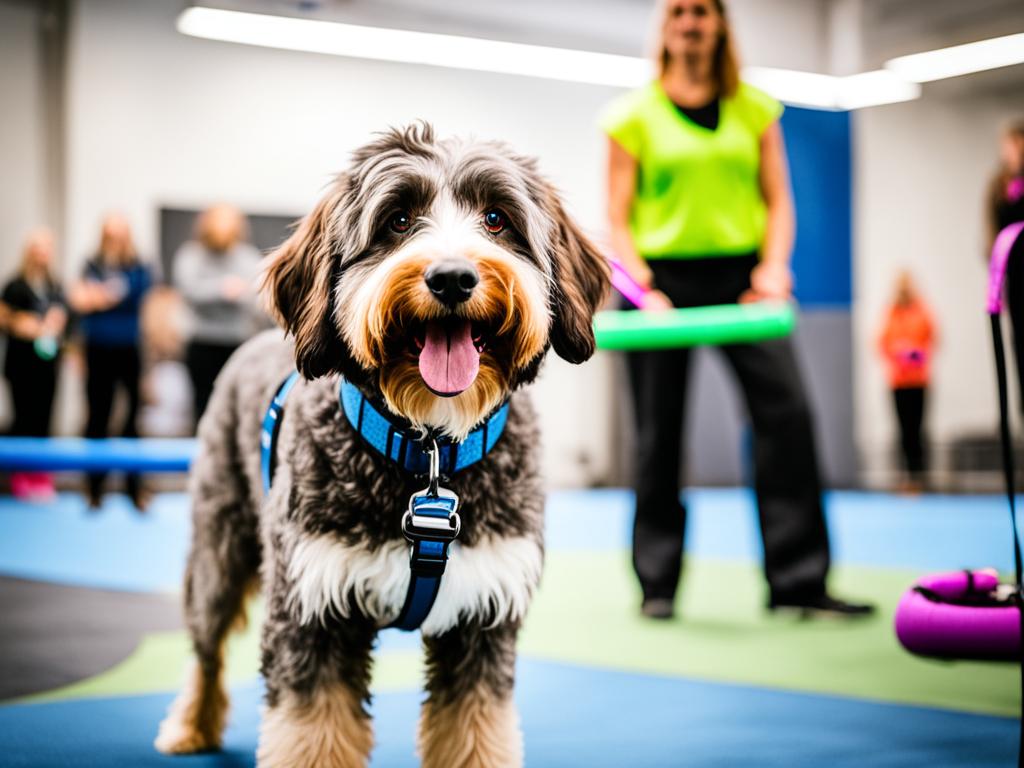
Aussiedoodle Training Tips:
- Set a consistent daily schedule for training sessions, meals, exercise, and rest.
- Use positive reinforcement, such as treats, praise, and toys, to reward good behavior.
- Consider incorporating clicker training to mark and reinforce desired behaviors.
- Act as a role model through mirror training to teach desired behaviors.
- Consult professional dog trainers for personalized training advice and guidance.
Aussiedoodle Training Sample Routine
Establishing a training routine is crucial for your Aussiedoodle’s development. A consistent schedule will help your pup understand what is expected of them and make training more effective. Here is a sample routine that you can follow:
| Activity | Timing |
|---|---|
| Waking Up | Take your Aussiedoodle for a potty break |
| Meal Time | Feed your dog and take them for a potty break afterwards |
| Exercise Sessions | Engage your Aussiedoodle in physical activities to burn off energy |
| Naptime | Provide a quiet and comfortable space for your dog to rest |
| Bedtime | Establish a consistent bedtime routine and ensure your dog is relaxed |
As your pup grows and matures, adjust the routine to their age and stage of development. Remember to be patient and consistent with your training efforts. A structured routine will help your Aussiedoodle thrive and become a well-behaved companion.
3 Obedience Training Methods For Your Aussiedoodle
When it comes to training your Aussiedoodle, there are several obedience training methods you can use to ensure they become well-behaved and obedient companions. By implementing these methods, you can effectively communicate with your dog and teach them the desired behaviors.
1. Positive Reinforcement Training
Positive reinforcement training is a highly effective method for training your Aussiedoodle. This training technique involves rewarding your dog for displaying good behavior, such as following commands or exhibiting desired behaviors. Rewards can include treats, praise, or playtime, and they serve as positive motivators for your dog.
This training method encourages your Aussiedoodle to repeat the behaviors that earn them rewards, creating a strong association between positive behavior and positive outcomes. It helps build trust and strengthens the bond between you and your dog.
2. Clicker Training
Clicker training is another popular obedience training method that can be used with your Aussiedoodle. This method involves using a distinct clicking sound to mark the specific behavior you want to reinforce. The click acts as a precise and immediate signal to your dog that they have performed the desired behavior correctly.
When your dog hears the click, they know that a reward will follow. The clicker serves as a communication tool, helping your Aussiedoodle understand which behaviors are being reinforced. It allows for clear and consistent communication, making the training process more effective.
3. Mirror Training
Mirror training involves acting as a role model for your Aussiedoodle. By demonstrating the desired behavior yourself, you can show your dog what is expected of them. This method can be particularly helpful for teaching complex behaviors or tricks.
For example, if you want to teach your Aussiedoodle to sit, you can first show them the action by sitting down yourself. Then, use verbal commands and hand signals to guide your dog into performing the behavior. Mirror training relies on your dog’s observational skills and ability to imitate your actions.
Remember to be consistent with rewards and avoid punishing your Aussiedoodle during the training process. Positive reinforcement methods have been proven to be more effective and promote a healthy and trusting relationship with your dog.
If you need additional guidance on these obedience training methods or want to explore more techniques, consider seeking advice from professional dog trainers. They can provide personalized training plans and expert insights to help you train your Aussiedoodle effectively.
The Training Items You Absolutely Need For Your Aussiedoodle
To successfully train your Aussiedoodle, there are certain items you’ll need. These include:
1. Collar and Leash
A high-quality collar and leash set is essential for ensuring control and safety during training sessions and walks. Choose a comfortable collar that fits your Aussiedoodle well and a sturdy leash that gives you control without causing discomfort.
2. Training Treats
Training treats are a valuable tool for positive reinforcement. Use small, soft treats that your Aussiedoodle finds irresistible to reward desired behaviors and reinforce training cues effectively. Remember to use treats in moderation and adjust your dog’s regular meals accordingly.
3. Clicker (if you choose to use clicker training)
Clicker training is a popular method that uses a distinct sound to mark desired behaviors. If you opt for clicker training, invest in a clicker and familiarize yourself with its proper use. Incorporate the clicker as part of your training routine to communicate clear signals to your Aussiedoodle.
4. Interactive Toys for Mental Stimulation
To keep your Aussiedoodle mentally engaged and prevent boredom, interactive toys are invaluable. These toys challenge your dog’s problem-solving skills and provide mental stimulation, which is just as important as physical exercise. Choose toys that are suitable for your dog’s size, energy level, and preferences.
5. Crate
A crate can serve as a valuable training tool for crate training and providing a safe space for your Aussiedoodle. Use a crate that is appropriately sized and comfortable for your dog, ensuring that it offers enough room for them to stand, turn around, and lie down comfortably. Proper crate training can help with housebreaking and prevent destructive behaviors when you’re not able to supervise your pup.
6. Training Books or Enrolling in Training Classes with Professional Dog Trainers
Consider investing in training books written by reputable dog trainers that provide comprehensive guidance on various training techniques and tips. Additionally, enrolling in training classes with professional dog trainers can be highly beneficial. These trainers have the experience and expertise to provide personalized guidance and support throughout the training process. Look for trainers who use positive reinforcement methods and have a good reputation in the dog training community.
Training Items for Your Aussiedoodle:
| Item | Description |
|---|---|
| Collar and Leash | A high-quality set for control and safety |
| Training Treats | Small, soft treats for positive reinforcement |
| Clicker (if using clicker training) | A distinct sound marker for desired behaviors |
| Interactive Toys | Toys to provide mental stimulation |
| Crate | A safe space for crate training and supervision |
| Training Books or Classes | Resources for guidance and expert support |
By having these training items on hand and utilizing them effectively in your training sessions, you can set your Aussiedoodle up for success and ensure a positive and rewarding training experience.
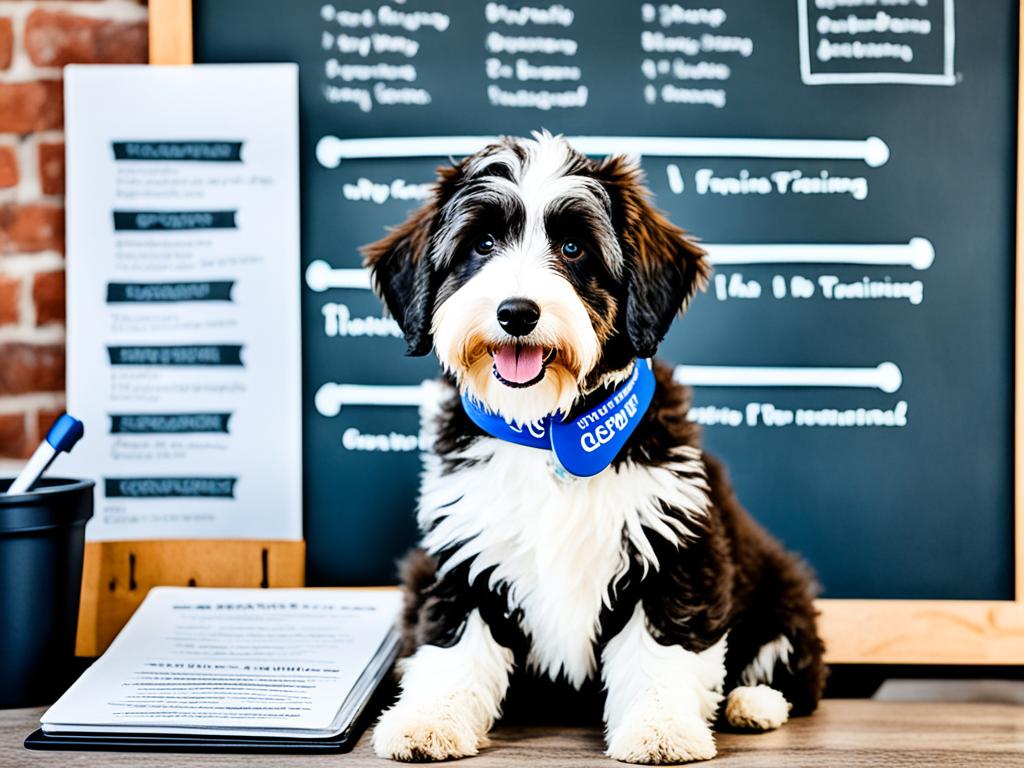
Aussiedoodle Training: Common Issues & How to Tackle Them
During the training journey of your beloved Aussiedoodle, you may encounter some common issues that require prompt and effective solutions. Addressing these problems with patience and the right approach is crucial for successful training. Here are a few common training issues you may experience and how to tackle them:
Potty Accidents:
Consistent potty training is essential to prevent accidents. Establish a routine for bathroom breaks and reinforce positive behavior. Use positive reinforcement such as treats and praise when your Aussiedoodle eliminates in the appropriate spot.
Chewing:
Aussiedoodles are prone to chewing as a way of exploring and teething. Provide appropriate chew toys to redirect their chewing urge towards approved items. Regularly rotate their toys to keep them engaged and prevent boredom.
Barking:
Excessive barking can be managed through positive reinforcement. Reward your Aussiedoodle when they are quiet and teach the “quiet” command. Identify the triggers that cause excessive barking and work on desensitization exercises to gradually reduce their response.
Pulling on the Leash:
Leash pulling can be frustrating, but it can be corrected with leash training techniques. Teach your Aussiedoodle to walk politely on a loose leash by rewarding them when they walk beside you. Use positive reinforcement and redirect their attention whenever they pull.
| Training Issue | Tackling Strategies |
|---|---|
| Potty Accidents | Establish a consistent routine for bathroom breaks and reinforce positive behavior using treats and praise. |
| Chewing | Provide appropriate chew toys, regularly rotate their toys, and redirect their chewing behavior. |
| Barking | Use positive reinforcement, teach the “quiet” command, and work on desensitization exercises. |
| Pulling on the Leash | Teach leash training techniques, reward loose leash walking, and redirect attention when they pull. |
Tackling these common training issues requires consistency, patience, and a positive approach. If you’re facing challenges or need personalized guidance, consider seeking assistance from professional dog trainers. They can provide expert advice and tailored training plans to address specific needs. With the right support and training methods, you can overcome these issues and have a well-behaved and happy Aussiedoodle.
Need Some Extra Help When Training Your Aussiedoodle?
If you feel like you need some extra help when training your Aussiedoodle, don’t hesitate to seek guidance from professional dog trainers. They are experienced in working with different breeds and can provide personalized training plans to address specific challenges.
Professional trainers offer advanced dog training techniques that can take your Aussiedoodle’s training to the next level. Whether you’re looking to perfect their obedience skills, tackle behavioral issues, or teach advanced tricks, professional trainers have the knowledge and expertise to assist you in achieving your training goals.
Enrolling in group dog training classes can also be beneficial for your Aussiedoodle. These classes provide structured environments where your pup can learn alongside other dogs, helping to improve their socialization skills and overall behavior. It’s a great opportunity for your Aussiedoodle to interact with other dogs and people while receiving guidance from a professional trainer.
When searching for Aussiedoodle training classes near you, consider asking for recommendations from other dog owners or conducting an online search. Look for trainers who use positive reinforcement methods and have experience working with Aussiedoodles or similar breeds.
Benefits of Professional Dog Training for Your Aussiedoodle
Working with a professional dog trainer offers several benefits for both you and your Aussiedoodle:
- Expert guidance: Professional trainers have the knowledge and experience to assess your dog’s unique needs and develop a training plan tailored to them.
- Effective techniques: Trainers are familiar with a variety of training methods and can choose the most appropriate ones for your Aussiedoodle, ensuring they respond positively and make progress.
- Structured approach: Professional trainers provide a structured environment and training regimen, which helps your Aussiedoodle understand expectations and learn more efficiently.
- Consistency: Trainers emphasize consistent training techniques, promoting better behavior and reducing confusion for your furry friend.
- Personalized support: A professional trainer can address any specific challenges or issues you may be facing with your Aussiedoodle, offering tailored solutions and ongoing support.
Remember, training your Aussiedoodle is a journey that requires time, patience, and dedication. With the help of a professional trainer and the right training classes, you can establish a strong bond with your Aussiedoodle while ensuring they become a well-behaved and happy member of your family.
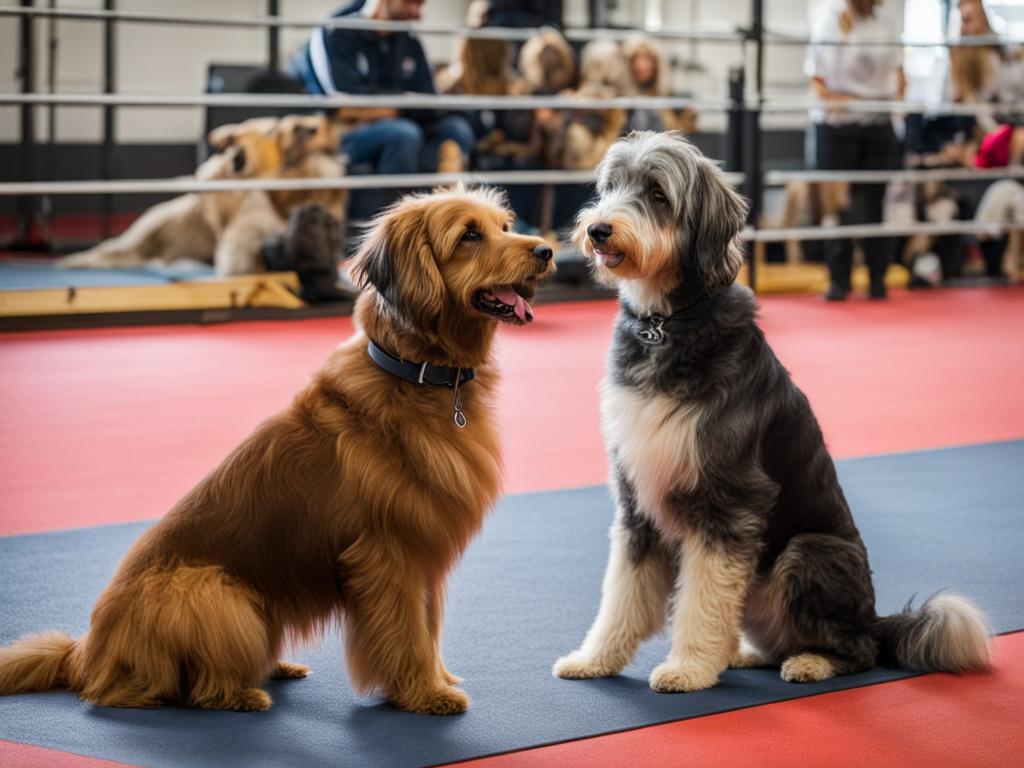
Aussiedoodle Training: Frequently Asked Questions
As you embark on your Aussiedoodle training journey, you may have some common questions. Here are answers to frequently asked questions related to dog training, puppy training, obedience training, behavioral training, and more.
1. How do I crate train my Aussiedoodle?
Crate training is a useful tool for housebreaking and providing a safe space for your Aussiedoodle. Start by introducing the crate gradually, making it comfortable with bedding and treats. Associate positive experiences with the crate and gradually increase the amount of time your Aussiedoodle spends inside. Avoid using the crate for punishment.
2. How can I effectively housebreak my Aussiedoodle?
Housebreaking requires consistency and patience. Establish a regular schedule for bathroom breaks, reward your Aussiedoodle for appropriate elimination outside, and supervise them closely indoors to prevent accidents. Use positive reinforcement techniques and be consistent with training.
3. How do I deal with separation anxiety in my Aussiedoodle?
Separation anxiety is a common issue in dogs. Gradual desensitization and counterconditioning can help your Aussiedoodle feel more comfortable when left alone. Start by leaving them for short periods and gradually increasing the duration. Provide engaging toys or puzzle feeders to keep them occupied. Seek guidance from a professional dog trainer for personalized advice.
4. How can I teach basic commands to my Aussiedoodle?
Teaching basic commands like “sit,” “stay,” and “come” is essential for obedience training. Use positive reinforcement techniques such as treats or praise to reward desired behaviors. Break down each command into small, manageable steps and gradually increase expectations. Consistency and patience are key.
5. What should I do if my Aussiedoodle displays unwanted behaviors?
If your Aussiedoodle exhibits unwanted behaviors like jumping, excessive barking, or chewing, it’s important to address them promptly. Redirect their focus to appropriate behaviors and provide plenty of mental and physical stimulation. Avoid punishment and seek guidance from professional dog trainers for effective solutions.
| Topic | Answer |
|---|---|
| Crate training | Gradually introduce the crate, associate positive experiences, and avoid using it for punishment. |
| Housebreaking | Establish a regular schedule, reward appropriate elimination outside, and supervise closely indoors. |
| Separation anxiety | Utilize desensitization techniques, provide engaging distractions, and seek guidance from a professional trainer. |
| Teaching basic commands | Use positive reinforcement, break down commands into manageable steps, and be consistent. |
| Unwanted behaviors | Redirect focus, provide mental and physical stimulation, and consult professional trainers for guidance. |
Remember, every dog is unique, and it’s important to tailor your training approach to your specific Aussiedoodle’s needs. Consult with professional dog trainers to address any additional questions or concerns you may have, and utilize online resources and forums dedicated to dog training for valuable information and support.
Final Thoughts
Raising a well-behaved Aussiedoodle takes time and effort, but the results are worth it. With consistency, positive reinforcement, and appropriate socialization and training, your Aussiedoodle can grow into a well-mannered and confident companion.
Start training at a young age, as early training sets the foundation for good behaviors. Establish a routine that provides structure and security for your pup. Use effective training methods such as positive reinforcement, clicker training, or mirror training to teach desired behaviors.
Don’t hesitate to seek guidance from professional dog trainers who specialize in obedience training and behavior modification. Their expertise can provide personalized advice and support throughout the training process.
Remember, training is an ongoing process. It requires patience and dedication to achieve consistent results. Celebrate the small victories and stay committed to your training goals. Your hard work will pay off as you see your Aussiedoodle transform into a well-trained and obedient companion.
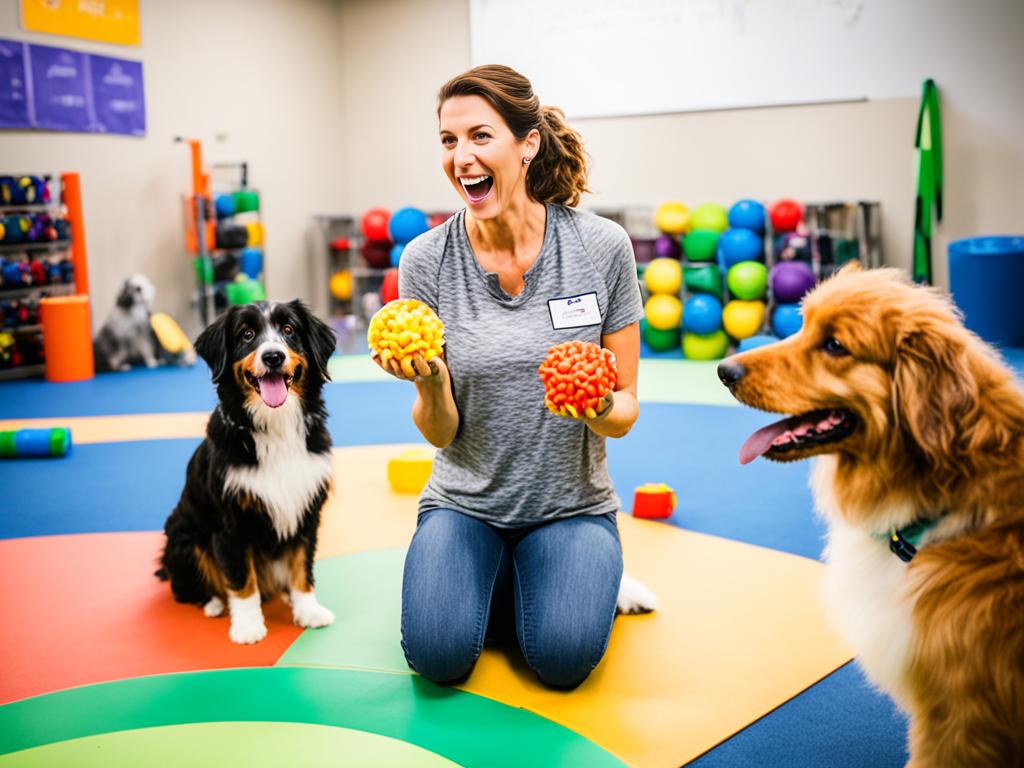
Aussiedoodle Breed Overview
The Aussiedoodle is a crossbreed between the Australian Shepherd and Poodle. This intelligent breed is known for its affectionate nature and makes a great companion dog. Aussiedoodles require considerable attention, exercise, and mental stimulation. They have a high energy level and thrive on engaging activities. The coat of an Aussiedoodle can vary depending on the parents’ coloring and may resemble that of the Australian Shepherd or Poodle. It’s important to provide proper grooming and care for their well-being.
When it comes to intelligence and personality, the Aussiedoodle inherits the best traits of both the Australian Shepherd and Poodle. They are highly trainable and eager to please their owners. With their versatile nature, Aussiedoodles excel in various roles such as therapy dogs, service dogs, and agility competitors. Their affectionate and loyal temperament makes them excellent family pets and reliable companions.
Exercise is essential for Aussiedoodles as they have a natural inclination towards physical activities. Daily walks, runs, or playtime in a secure area are necessary to fulfill their exercise needs. Mental stimulation is equally important, and interactive games, puzzle toys, and obedience training sessions can keep them mentally engaged.
When it comes to grooming, the coat of an Aussiedoodle requires regular brushing to prevent matting and tangling. The frequency of grooming depends on the length and texture of the coat. Professional grooming may be required to maintain their coat’s health and appearance. Additionally, regular check-ups with a veterinarian and a balanced diet are essential for the overall well-being of your Aussiedoodle.
In summary, the Aussiedoodle is a crossbreed with a mix of intelligence, affection, and energy. Providing proper care, exercise, and mental stimulation will help ensure a happy and healthy life for your Aussiedoodle.
Finding Aussiedoodle Training Classes Near You
If you’re looking for Aussiedoodle training classes near you, there are several options to consider. One effective way is to seek recommendations from other dog owners in your local community. They can provide valuable insights and share their experiences with professional dog trainers. Additionally, you can check online directories that list local trainers and their services. These directories often provide reviews and ratings from previous clients, helping you make an informed decision.
Another method is to use search engines to find professional dog trainers in your area. By entering keywords such as “Aussiedoodle training classes near me” or “local dog trainers,” you can discover trainers who specialize in Aussiedoodle training and are located close to your home.
Local pet stores and training centers are also great resources for finding training classes. They often offer group training sessions that focus on socialization and obedience skills for dogs like the Aussiedoodle. Not only will this help your furry friend learn important commands, but it will also provide opportunities for them to interact with other dogs.
When choosing a trainer, take the time to thoroughly research and read reviews to ensure you find reputable professionals who use positive reinforcement methods. This training approach promotes a healthy and enjoyable training experience for your Aussiedoodle, resulting in a harmonious relationship between you and your pet. Start your Aussiedoodle’s training journey on the right foot by enlisting the help of experienced trainers in your local community.
FAQ
When is the best age to start training an Aussiedoodle puppy?
It is recommended to start training your Aussiedoodle puppy at a young age to set the foundation for good behaviors. Responsible breeders often start training before adoption, focusing on socialization, potty training, crate training, and basic manners. Continuing with training after adoption is essential for their development.
What are the different training methods for Aussiedoodles?
There are several effective training methods for Aussiedoodles, including positive reinforcement training, clicker training, and mirror training. Positive reinforcement involves rewarding good behavior, while clicker training uses a distinct sound to mark desired behavior. Mirror training involves acting as a role model for your pup. Seek guidance from professional trainers for personalized training advice.
What should be included in an Aussiedoodle training routine?
An Aussiedoodle training routine should include regular potty breaks, exercise sessions, meal times followed by potty breaks, and consistent bedtime. Adjust the routine as your pup grows. This provides structure and helps your Aussiedoodle understand what is expected of them.
What obedience training methods are recommended for Aussiedoodles?
Positive reinforcement training, where you reward good behavior, is highly recommended for Aussiedoodles. Clicker training, using a distinct sound to mark desired behavior, is another effective method. Mirror training, where you model desired behavior, can also be helpful. Seek guidance from professional trainers for more information on these training methods.
What items do I need for training my Aussiedoodle?
For training your Aussiedoodle, you will need a collar and leash, training treats, a clicker (if using clicker training), interactive toys for mental stimulation, and a crate for crate training and providing a safe space.
How can I address common training issues with my Aussiedoodle?
Common training issues such as potty accidents, chewing, barking, and leash pulling can be addressed through consistent potty training, providing appropriate chew toys, positive reinforcement for managing barking, and using leash training techniques. Professional trainers can offer expert guidance in tackling these issues.
Where can I find Aussiedoodle training classes near me?
To find Aussiedoodle training classes near you, you can seek recommendations from other dog owners, check online directories, or search for professional dog trainers in your area. Local pet stores and training centers often offer group training classes for socialization and obedience skills.
What are some frequently asked questions about Aussiedoodle training?
Frequently asked questions about Aussiedoodle training may include topics such as crate training, housebreaking, dealing with separation anxiety, and teaching basic commands. Professional trainers and online resources can provide answers to these questions and offer guidance specific to your Aussiedoodle’s needs.
When should I seek extra help when training my Aussiedoodle?
If you feel like you need extra help when training your Aussiedoodle, do not hesitate to seek guidance from professional dog trainers. They can provide personalized training plans, advanced techniques, and support to help you achieve your training goals. Group dog training classes can also provide socialization opportunities for your pup.
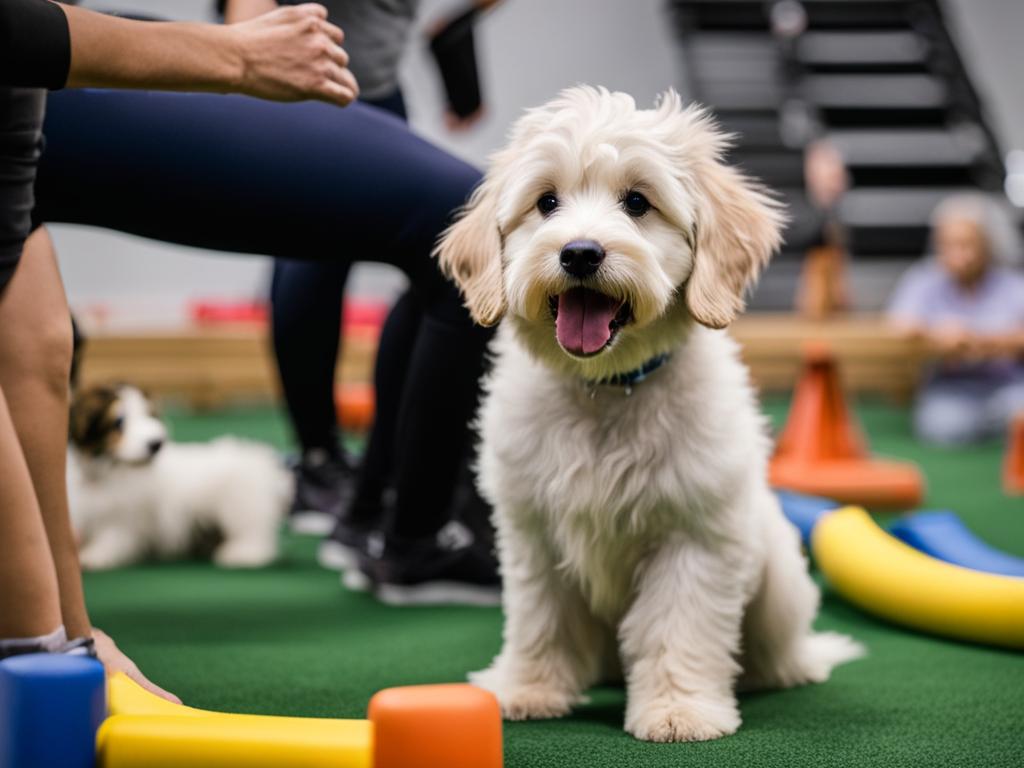
Leave a Reply